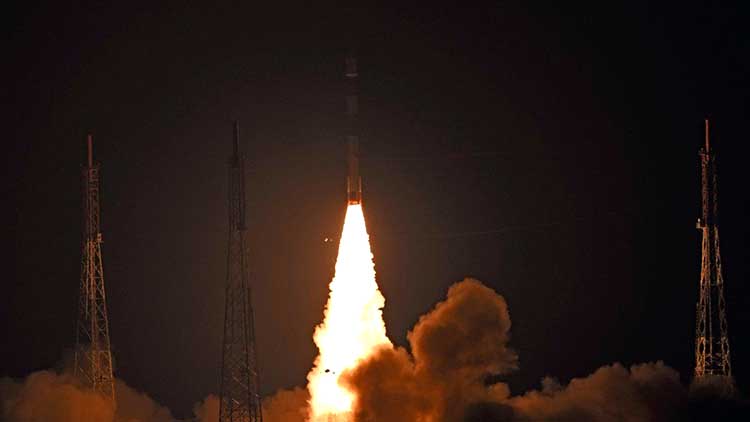India on Thursday night opened the year's space campaign by putting into orbit defence imaging satellite "Microsat R" for the Defence Research and Development Organisation (DRDO) and students-built nano-satellite "Kalamsat" in a copy book style.
The notable aspects of this space mission are flying of a new variant of Polar Satellite Launch Vehicle (PSLV), switching off and on of the fourth stage engine couple of times, and use of fourth stage as an orbital platform carrying Kalamsat.
After the successful launch, ISRO Chairman K. Sivan said: "The mission is a grand success. The PSLV rocket precisely injected the Microsat R in its designated orbit."
Sivan said, this PSLV rocket is not an another PSLV rocket as lot of innovation have been incorporated in it like the use of aluminium tank in the fourth stage and using it as an orbital platform for the five member student team and Space Kidz India built nano-satellite Kalamsat.
He said, the Indian space agency is ready to help all Indian students to conduct space experiments while ISRO would do the research for the benefit of the nation.
At 11.37 p.m, the 44.4-metre tall rocket blasted off from the first launch pad here.
With the fierce orange flame at its tail lighting up the night skies, the rocket slowly gained speed and went up and up enthralling the people at the rocketport, with the rocket's engine noise like a rolling thunder adding to the thrill.
More thrilling aspect came in when rocket's fourth-stage/ engine was cut/switched off in just over 13 minutes after the lift-off.
A minute later the DRDO's imaging satellite Microsat R was ejected at an altitude of about 277 km.
Speaking to IANS earlier, Sivan said the Microsat R is a 700kg satellite for DRDO.
"There is increased demand for satellites from strategic sectors. About six-seven satellites are planned to be built," a senior official told IANS earlier.
The GSAT-7 and GSAT-7A are the two dedicated military communication satellites, while all other earth observation and communication satellites launched earlier were of dual use -- civilian and defence.
The PSLV is a four-stage engine expendable rocket with alternating solid and liquid fuel.
In its normal configuration, the rocket would have six strap-on motors hugging its first stage.
But the 44.4-metre tall rocket that lifted off on Thursday had two strap-on motors and its configuration is designated as PSLV-DL.
At about 100 minutes after the lift-off, the rocket's fourth stage was switched on again for few seconds before it was again cut off.
Finally, at about 103 minutes after the rocket left the earth, the fourth stage began its role as an orbital platform carrying Kalamsat at an altitude of 450 km.
Kalamsat is a payload developed by students and Chennai-based Space Kidz India and the first to use the rocket's fourth stage as an orbital platform.
According to Srimathy Kesan, Founder CEO of Space Kidz India, Kalamsat is a 10cm cube, 1.2 kg communication satellite with a life span of two months. The satellite cost is about Rs 12 lakh.



Google sacks 28 employees involved in protests over Israel govt contract
Tech giant Google has laid off 28 employees who were involved in sit-in protests at its offices over a Google contract with the Israeli government.
'Made in India' tech like DPI can be transformative for the world: Bill Gates
Microsoft Co-founder and billionaire philanthropist Bill Gates on Saturday said that technologies like digital public infrastructure (DPI) that are created in India can be transformative for the world.
India is the next big playground for AI: Samsung VC, CEO JH Han
Samsung Electronics Vice Chairman, CEO and Head of the Device eXperience (DX) Division Jaong-Hee (JH) Han, who visited Samsung BKC at Jio World Plaza, Mumbai for the first time since the store's opening, said on Friday that India is the next big playground for artificial intelligence (AI).
ISRO's step towards realising Indian space shuttle 'Pushpak'
India progressed further in its attempt to realise a reusable launch vehicle (RLV)/ rocket named 'Pushpak' by successfully test landing RLV LEX-2 on Friday at the Aeronautical Test Range (ATR) in Karnataka's Chitradurga.
AI will be smarter than any single human by next year: Musk
Elon Musk who is currently locked in a battle with ChatGPT maker OpenAI said on Wednesday that artificial intelligence (AI) will probably be smarter than any single human by next year.
NASA’s Crew 7 targets March 12 to return to Earth
NASA’s Crew 7 astronauts onboard the International Space Station (ISS) are preparing to return to Earth, after a six-month stay in the orbiting lab, the US space agency has said.
Meta suffers mega outage as FB, Instagram, Messenger stop working for millions
In one of the worst outages for Meta in years, its entire family of apps -- Facebook, Instagram, Messenger and Threads -- went down for millions across the globe, including in India, as users were thrown out from their accounts.
Narendra Modi first PM to visit ISRO’s VSSC in 4 decades, meets Gaganyaan astronauts
Narendra Modi on Tuesday became the first Prime Minister to visit the Indian Space Research Organisation’s (ISRO) Vikram Sarabhai Space Centre (VSSC) in four decades, where he met the four astronaut-designates of India's Gaganyaan Mission